Alejandro Goyri
Carlos Valverde-R
México City, México

In his so-called “black period,” Francisco Goya created a series of oil paintings, engravings, and drawings that depict witches and mentally or physically disabled individuals. This is particularly clear in the Witches’ Sabbath (1819-1823), in which the facial expression of most of the characters (especially of the young seated woman seen in profile and clothed in white) strongly suggests mental retardation from congenital hypothyroidism or cretinism (Figure 1).
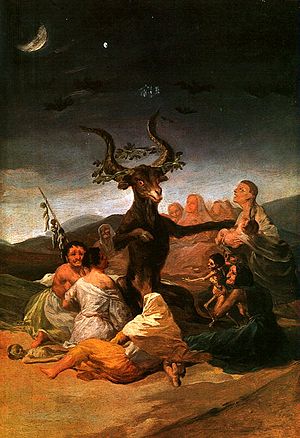
(Aquelarre),
1797-1798
Museo Lázaro Galdiano
Already in the seventeenth century, Paracelsus had noticed that many mentally disabled persons had goiters. It is now well known that the most frequent cause of goiter (thyroid gland enlargement) is the lack of dietary iodine, a worldwide public health concern and a major cause of neonatal hypothyroidism and mental retardation.
Witches’ Sabbath, also known as Aquelarre,1 is part of the collection of the Prado in Madrid, and has as its antecedent the painting of the Osuna Duckes in the state in Alameda. The work, which is related to the series known as Caprichos y Disparates, was probably influenced by Goya’s reading (ca. 1812) of the Trial (Auto-da-fé) of the Basque Witches at Logroño (1610). An account of the trial was written, with humorous annotations, by his friend Leandro Fernandez de Moratin. By using the grotesque and his wit to satirize the ecclesiastic attitudes towards certain supposedly satanic practices, Goya intended to deride the rampant obscurantism of the church.
In his earlier painting of the same name, Witches’ Sabbath or Aquelarre (1797-1798) shows a group of poor, handicapped, or malformed women prostrated around a figure of a male goat that symbolizes the devil Beelzebub (Figure 2). The women assembled are participating in a ceremony known as Witches’ Sabbath in which the young female seated in profile and clothed in white will be initiated in the satanic witchcrafts. The facial expression of this white-dressed figure strongly suggests imbecility or mental retardation, and most of the characters portrayed in the painting also resemble mentally disabled individuals. Both theme and composition reveal the genius of the Spanish painter, who, by anticipating expressionism, succeeds in representing a critical account of religious fanaticism. Indeed, Goya’s brush-strokes herald what at the end of the 19th century the Nordic painter Eduard Munch would paint in his famous work The Scream.
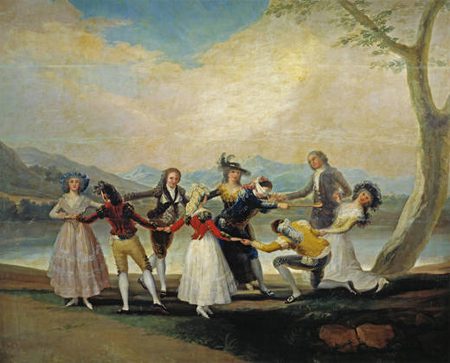
1789
Museo del Prado
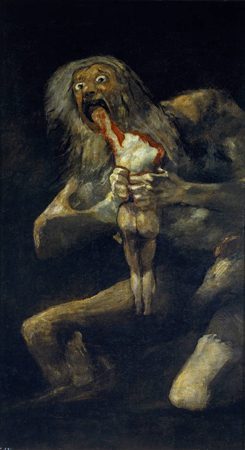
c. 1819-1823
Museo del Prado
The painting is a brilliant ironic criticism of religious swindle and the dominance of ignorance over rational thinking. As Goya himself states in a note published in the press (Diario de Madrid, February 6th, 1799) to promote his work:
A set of capricious themes invented and etched by Don Francisco de Goya. Convinced that the censorship of human vices and mistakes can be the subject of painting, the author has chosen, among the multitude of extravagancies and misconceptions common to all civil societies, and the ordinary uncertainties and deceits authorized by tradition, ignorance or interest, those matters he considers most adequate to provide material to mock and simultaneously allow him to exercise his fantasy.
This cruel and grotesque world depicted in Goya’s so-called “black period” differs strikingly from the relaxed scenery, sometimes jolly and funny and at other times severe and solemn, in which the artist represents the courtly life and the public entertainment of his epoch. This contrast is fully evident in the painting titled Blind Man’s Bluff (Figure 3). Indeed, in his famous series of oil paintings, engravings, and drawings, Caprichos and Disparates, Goya portrays characters related not only to the demonic ideal, but also to the monstrous part of humankind. In many cases the images refer directly to his observations of ill, demented, and homeless people. It is not only the contrast between the different periods and styles of Goya that deserves attention, but also his sensitive and wide perception of reality.
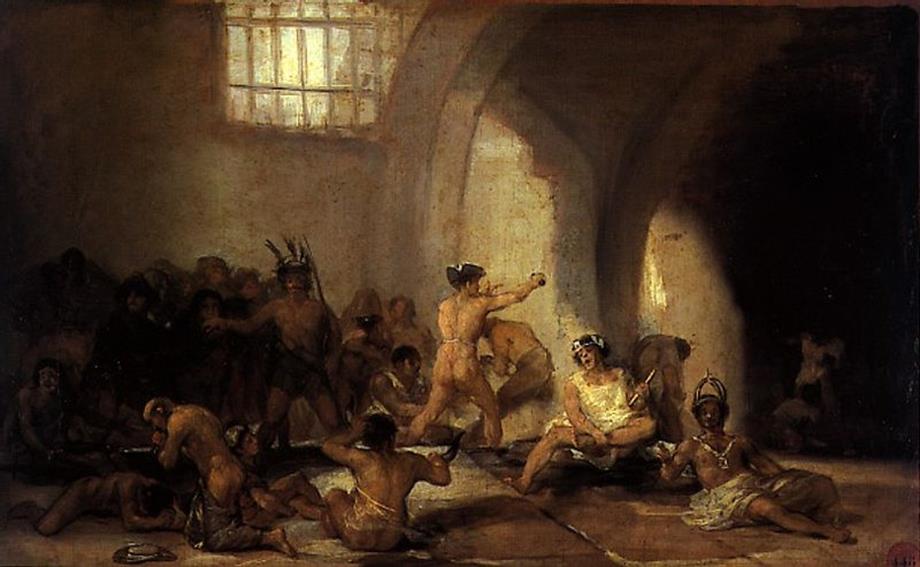
Meadows Museum
It should be acknowledged that the frequent presence of hunchbacked characters, deformed and ill like midgets and buffoons, is not a particular trait of Goya’s paintings. On the contrary, it is a feature that belongs to a plastic tradition and was certainly preferred by the Spanish Court, which incorporated into its entourage all such people. What Goya does, just like Diego de Velázquez, is to portray them, nothing more.2 Yet, his personal accent is a critical gaze, not emphasizing the cruelty, but rather displaying the grotesque, painful, and sometimes fantastic component of the Spanish reality of his time. He was also mordantly criticizing a society full of contrasts, cruelty, and inequality. Like many other intellectuals and artists of his time, Goya was a liberal man.
It can be said that the way he sees and portrays reality is the view of a fair man that uses his pictorial talent to leave an authentic and invaluable testimony of his life amongst the privileges available to a famous artist sheltered by the ostentation of the Spanish court.
Goya was born near Zaragoza, in the small town of Fuendetodos, where the hospital Nuestra Señora de Gracia Royal and General Hospital of Zaragoza was located and in which there was a department for demented and mentally ill patients. It is now known that between 1762 and 1764, when Goya was about 16 years old, his maternal aunt and uncle, Francisca Lucientes and Franciscao Lucientes, were inmates at this institution. Thus, although it cannot be proven, it is feasible that the young artist, living at that time with his mother, visited his mentally disturbed family members. Goya was not indifferent to the pain and suffering caused by sicknesses nor to the hell of madness (Klein, 1998); instead, he took his time to study and observe it closely. Thus, in his series Caprichos and Disparates, he masterfully captures and reflects the devastating effects of insanity, communicating it with sensitivity and creativity to the viewer in his hallucinating paintings. In his masterful Saturn devouring his son,3 he inaugurates the modern art of the twentieth century, one hundred years before the avant-garde movements even had their page in Western art history (Figure 4).
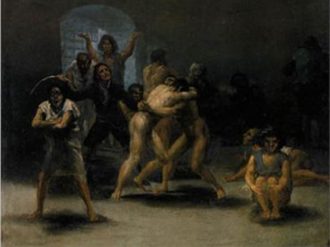
or Asylum (Manicomio), 1812-1819
Real Academia de Bellas Artes de San Fernando
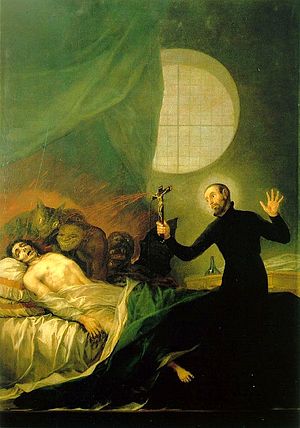
Likewise, some of these images reveal Goya’s acute perception of illnesses that produced both physical and mental disorders (Figures 5 and 6). Not all of the characters suffer from the same illness, but there is a clear impression, both in the morphologic composition of the inmates and in the expression on their faces, that they suffer from certain idiocy, and there is certain protuberance in the neck of some of them that can seen by close inspection.
Clearly Goya’s intention was not to use his pictorial art to make what could be considered a scientific drawing or painting, but his acute visualizations of diseased people certainly show the importance of his works to the history of medicine. As a colophon to this brief encounter between the paintings of one of the greatest artists of all time and medicine, more specifically with madness and neurological disorders produced by hypothyroidism, we introduce one of his most amazing works related to the human cycles of life and death, his painting of St. Francis Borgia now in the Cathedral of Valencia (Figure 7).
Notes
- The word Aquelarre may come from Basque, and it means “in the male goat’s field.”
- So much so, that the famous picture of Velázquez, Niño de Vallecas, which we record and comment elsewhere (Valverde-R, and Ortiz Bulle-Goyri, 2015), was a reason for another of Goya’s paintings, which unfortunately is lost.
- On the hypertext of the webpage of la Junta de Castilla y León the following is written: “Saturn devouring his children is one of Goya’s most heartbreaking and tragic Black Painting. . . . Goya, just like Rubens in his Saturn, has chosen the moment in which the God of Time tears down the body of his own son so that no one could dethrone him. But Jupiter escaped the cannibalistic rite of his father and managed to end his tyranny. A totally dark space surrounds the silhouette of the god, which highlights his deformity and his monstrous face. It is a magnificent representation of how time devours everything, one of the obsessions of the artist. Most experts suggest that Goya’s old age would motivate a decoration in which melancholy and sadness for time past would take precedence, though references to the present are still there. It has even been interpreted as Ferdinand VII devouring his children.”
References
- Goya, Francisco de. Diary. 6 February 1799.
- Junta de Castilla y León. https://www.jcyl.es/
- Klein, Peter K. “Insanity and the Sublime: Aesthetics and Theories of Mental Illness in Goya’s Yard with Lunatics and Related Works.” Journal of the Warburg and Courtauld Institutes 61 (1998): pp. 198-252.
- Valverde-R C y Ortiz Bulle-Goyri A. Un Torbellino de Miradas a la Tiroides. Su Historia a Través del Mito, el Arte y la Ciencia. UNAM, 2015 (en prensa).
ALEJANDRO ORTIZ BULLÉ GOYRI is presently at Departamento de Humanidades, División de Ciencias Sociales y Humanidades, Universidad Autónoma Metropolitana-Azcapotzalco.
CARLOS VALVERDE-R is presently at Instituto de Neurobiología, Universidad Nacional Autónoma de México-Campus Juriquilla.
Acknowledgments
The authors thank Dr. Dorothy Pless for critically editing and reviewing the manuscript.
Highlighted in Frontispiece Volume 8, Issue 3 – Summer 2016

Leave a Reply